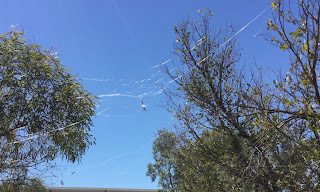Between the campus and the cloud
Golden Silk Orb-weaver spider
Image: Wendy Taleo, 2017
Somewhere between
the campus and the cloud
my stories lie hidden
until shared.
Clear and loud.
Then I listened to this conversation:
Architecture, War, and the Erasure of Identity
Right, war and everything, this might be a different and deeper connection to buildings and place. One of the great quotes from this conversation is:
People are people within the place.and
One of the way to get rid of history is to remove all physical traces of history.There is a further discussion about whether learning places need artifacts at all. I certainly think that my travels would be very different if there were not old buildings to visit, photos to see and things to touch. How would Rome look without fallen down stone artifacts for us to stand and imagine how they formed impressive buildings? How would you feel if your University campus was raised to the ground tonight? Would that make a difference to you? Or to your culture?
Here is an odd place on campus at the moment. Near the end of the short clip you can see a mountain range in the background. Just to give you some context, there is 1,200km in any direction, of much open space and desert lands, to get to a bigger town (Pop 23,000) to where I live. The gap in the fence is particularly amusing. Sure, it will be fixed and the boom gate will be placed neatly in the gap. This will deter the 4 wheel traffic but I'm sure the foot traffic will continue to use this space and create new desire paths that join the old.
One of the justifications for the fence is to reduce foot traffic that doesn't 'belong' in the University campus. My office faces out onto this space and has it's windows smashed on more than one occasion. I can appreciate the need to try and reduce this temptation for senseless damage. However I also wonder about the native life and the disruption these fences will cause. On the more metaphorical side, I'm thinking about the technological fences that are erected and who gets impacted by that? The optimistic approach is that technology would give us more ways to connect, safer paths, well organised web-roads but the realist in me sees fences and disrupted desire paths. I've appreciated Network Narratives for showing paths between on campus and 'open participants'.
Simon Ensor talks about Criss-crossing in his recent post. This interaction across border lines and timezones is particular to the 3rd space where my learning and connections happen. As I chat to Maha Bali she is just waking up as I'm preparing to wind down for the week. We are talking about virtually connecting across London and New Orleans in early April with Virtually Connecting for OLC Innovate and OER17 conferences. Yesterday I worked synchronously with Sundi Richards a few timezones away, on the blog post in Google docs related to these activities. This is very different energy to talking to people at the coffee shop here on campus as we grab a lunchtime lamb yiros . I like these different energies. I'll keep searching for open gates and gaps in the fences.



I'm really happy you are thinking about the "place-ness" of being an online student; it always seems the total focus is on the courses/content and leaves out all the other parts of human experience that happens while taking classes.
ReplyDeleteI believe I mentioned that in 2010 I was part of a brainstorming meeting that was aimed at asking the question of what is the "campus life" for online/distant students; not sure anything significant came of of it, but found the wiki I built then for the event http://oet10.wiki.nmc.org/
Sadly, online, the gates and memory spots are more easily plowed down than metal gates and physical buildings. So the memory making is more on us than the institutions.
And if we go down the other metaphor rabbit hole, there are the endless roundabouts in Milton Keynes (I spent a week slinging around them)